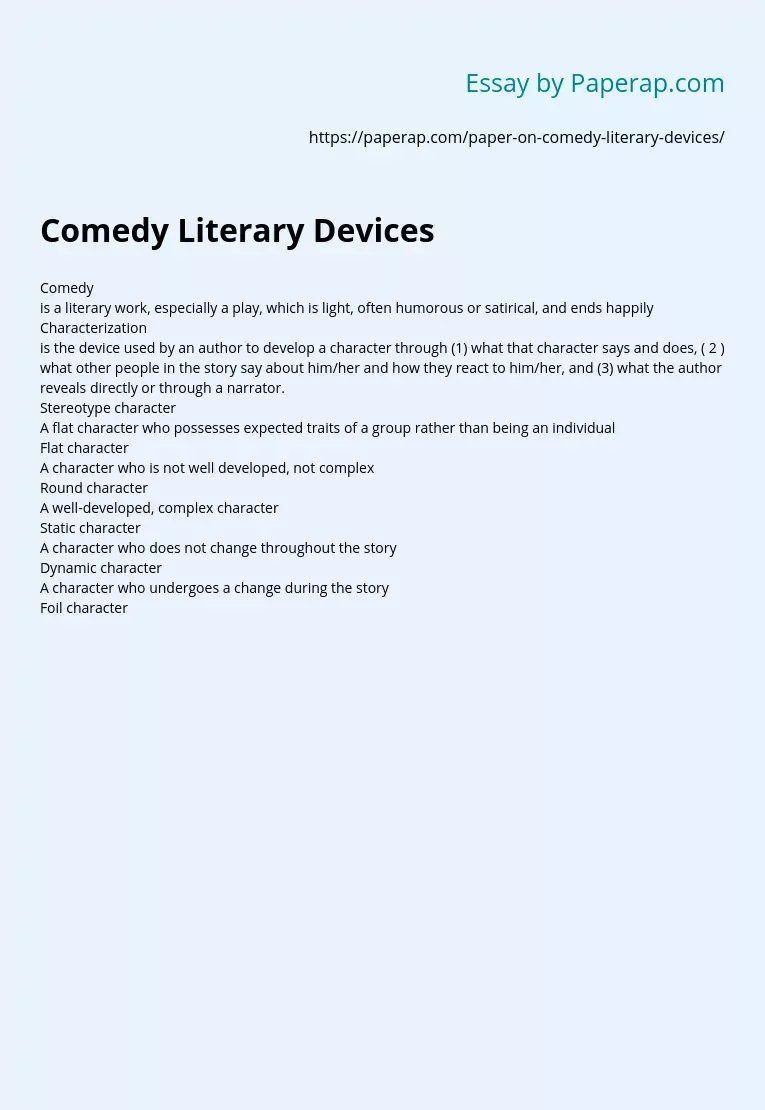Comedy Literary Devices
Essay,
Pages 3 (535 words)
Views
51
Comedy
is a literary work, especially a play, which is light, often humorous or satirical, and ends happily
Characterization
is the device used by an author to develop a character through (1) what that character says and does, ( 2 ) what other people in the story say about him/her and how they react to him/her, and (3) what the author reveals directly or through a narrator.
Stereotype character
A flat character who possesses expected traits of a group rather than being an individual
Flat character
A character who is not well developed, not complex
Round character
A well-developed, complex character
Static character
A character who does not change throughout the story
Dynamic character
A character who undergoes a change during the story
Foil character
A character who is in direct contrast to another character
External conflict
the struggle of a character against an outside force, such as fate, nature, society, or another person
Internal conflict
a character’s conflict with himself/herself
Verbal irony
when the speaker or writer says one thing but means something very different–often opposite of what is said (sarcasm)
Situational irony
what actually happens is opposite of what is expected or appropriate
Dramatic irony
occurs when the audience or the reader knows something important that the character does not know
Juxtaposition
placing dissimilar items, descriptions, or ideas close together or side by side, especially for comparison or contrast
Hyperbole
obvious and intentional exaggeration.
Understatement
The opposite of hyperbole, an understatement says less than is intended.
Understatement usually has an ironic effect, and sometimes may be used for comic purposes
Oxymoron
Two contradictory words used together, as in “sweet sorrow,” “original copy,” or “jumbo shrimp”
Alliteration
the repetition of the same sounds, such as “Sally sells sea shells”
Onomatopoeia
words that sound like what they mean, such as “plop”
Diction
The writer’s choice of words.
Diction expresses tone.
Tone
a writer’s or speaker’s attitude toward the subject
Theme
the underlying message of the story; the central idea behind the story; an expression of the author’s attitude
Figurative Language
Words or phrases that mean something other than what they literally say.
Simile
Figurative language that makes a comparison between two things, usually using “like” or “as”
Metaphor
Figurative language that makes a comparison between two things without the use of such specific words of comparison as like, as, than, or resembles
Personification
Figurative language in which an object or animal is given human qualities
Farce
a comedy characterized by broad satire and improbable situations
Satire
a type of writing that ridicules the shortcomings of people or instructions in an attempt to bring about a change
Foreshadowing
the use of hints and clues to suggest what will happen later in a plot
Drama
a play
Allusion
a reference to another literary work, a myth, a historical figure or event
Fiction
An made-up story, whether in prose, poetry, or drama (fake)
Non-fiction
prose writing that presents and explains ideas or that tells about real people, places, objects, or events (not fake)
Prose
ordinary form of written language, opposite of poetry
Poetry
written in lines and stanzas, opposite of prose
Imagery
description that uses any of the 5 senses
Mood
the emotional feeling of a story, often created through imagery
Comedy Literary Devices. (2018, Mar 02). Retrieved from https://paperap.com/paper-on-comedy-literary-devices/

